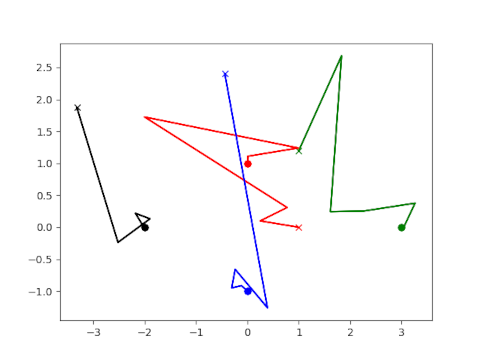In 1891 Karl Weierstrass developed a method for numerically finding all the roots of a polynomial at the same time. True to Stigler’s law of eponymy this method is known as the Durand-Kerner method, named after E. Durand who rediscovered the method in 1960 and I. Kerner who discovered it yet again in 1966.
The idea of the Weierstrass-Durand-Kerner method is to imagine you already had all but one of the roots and write down the expression you’d use to find the remaining root. Take a guess at all the roots, then solve for each root as if the remaining roots were correct. Iterate this process, and hopefully the process will converge on the roots. I say “hopefully” because the method does not always converge, though it often works very well in practice [1].
Here’s a Python implementation of the method for the special case of 4th degree polynomials. The general case is analogous.
def maxabs(a, b, c, d):
return max(abs(a), abs(b), abs(c), abs(d))
# Find roots of a 4th degree polynomial f
# starting with initial guess powers of g.
def findroots(f, g):
p, q, r, s = 1, g, g**2, g**3
dp = dq = dr = ds = 1
tol = 1e-10
while maxabs(dp, dq, dr, ds) > tol:
dp = f(p)/((p-q)*(p-r)*(p-s)); p -= dp
dq = f(q)/((q-p)*(q-r)*(q-s)); q -= dq
dr = f(r)/((r-p)*(r-q)*(r-s)); r -= dr
ds = f(s)/((s-p)*(s-q)*(s-r)); s -= ds
return p, q, r, s
Lets apply this to the polynomial
(x² + 1)(x + 2)(x – 3)
whose roots are i, –i, -2, and 3.
f = lambda x: (x**2 + 1)*(x + 2)*(x-3)
findroots(f, 1 + 1.2j)
Here is a plot of the iterates as they converge to the roots.

Each color corresponds to a different root. Each starts at the initial guess marked with × and ends at the root marked with a circle.
[1] Bernhard Reinke, Dierk Schleicher and Michael Stoll. The Weierstrass–Durand–Kerner root finder is not generally convergent. Mathematics of Computation. Volume 92, Number 339.

Interesting algorithm.
Of course, anyone using it should be careful with the choice of g. Just playing around with your small code and that particular polynomial, I found a few examples that either lead to a division by zero or non convergence:
a) g = 0 + 0j (division by zero)
b) g = 1 + 0j (division by zero)
c) g = any number real number (zero imaginary part) (doesn’t converge)
d) I would have expected that exp(pi*2.0j/3) would not converge (division by zero), the small perturbation introduced by the floating point arithmetic is enough to let it converge (dp = -2103871358771620.750+5785646236621951.000j for the first iteration though ;-) )
There is of course a ton of questions that come to mind:
1) Where the stating points part of the original algorithm or did you choose them to be 1,g,g**2,g**3 yourself?
2) Are you aware of robust choice of starting points?
3) What if the impact on convergence in the presence of roots with multiplicity greater than 1.
4) Are there other algorithm based on a Newton-Raphson that would increase the rate of convergence for finding all the roots at once?
So many questions, so little time… ;-)
” g = any number real number (zero imaginary part) (doesn’t converge)”
The paper by Reinke, Schleicher and Stoll mentions this case: “for instance, when the polynomial is real but some of its roots are not, then any purely real vector of starting points cannot converge to the roots, since the method respects complex conjugation.”
I came across this case myself when I tried out this method to find the fourth roots of unity, but it applies to the example polynomial int he post as well.
Thanks Michael for your comment and in particular the link to the PDF. I have some reading to do now :-)